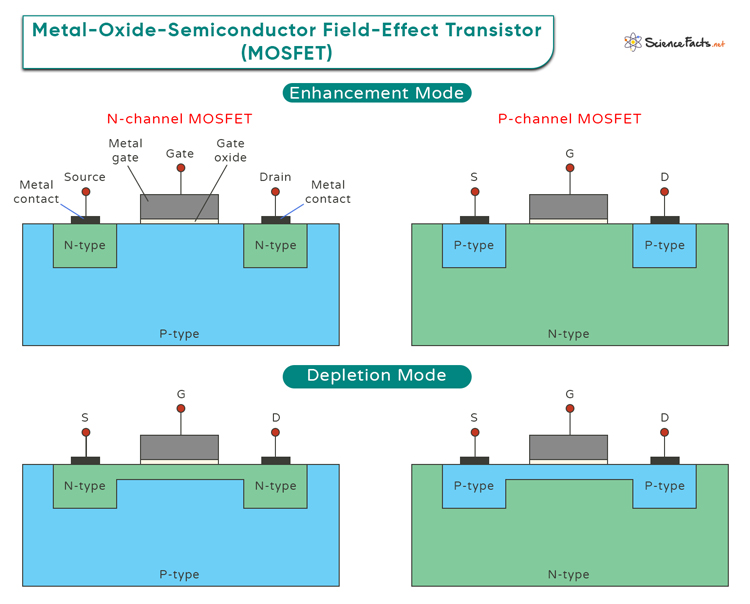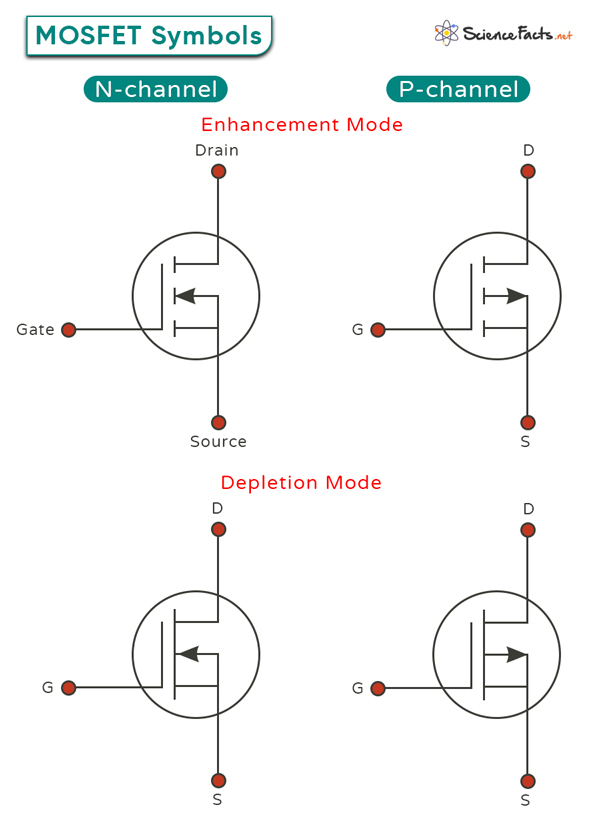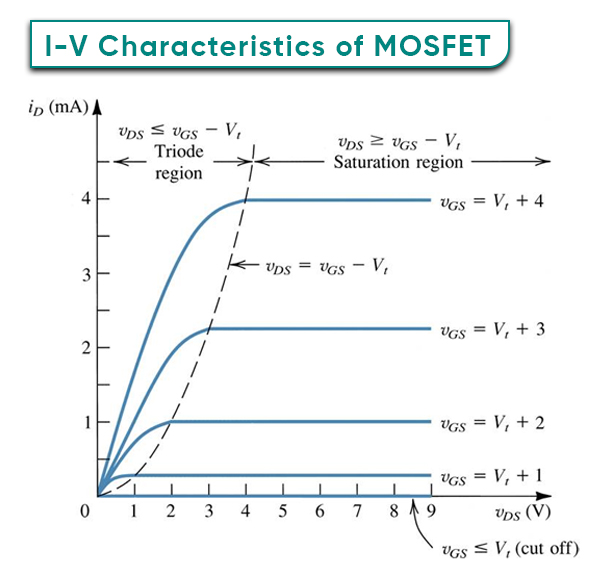MOSFET
MOSFET, short for Metal-Oxide-Semiconductor Field-Effect Transistor, is a type of field-effect transistor that can control the flow of electrical current. It is used for amplifying or switching electronic signals.
MOSFETs are widely used in various applications, including computers and smartphones, because they are efficient, fast, and can be miniaturized.
Construction
The construction of a MOSFET involves various layers and components.
1. Substrate: The substrate is the foundation of the MOSFET and is usually made of silicon.
2. Oxide Layer: Above the substrate is the oxide layer, which acts as an insulator to prevent current leakage.
3. Gate: The gate is located atop the oxide layer and controls MOSFET’s conductivity by applying a voltage.
4. Source and Drain: These two regions are located on either side of the gate. When the gate voltage activates them, they allow current to flow from the source to the drain.
5. Channel: The channel forms underneath the oxide layer between the source and the drain. When the transistor is in the “on” state, the channel acts as a pathway for current flow. The width of the channel is controlled by the voltage applied to the gate.
There are two types of channels:
- N-channel: Made of N-type semiconductors. Electrons are used as charge carriers to conduct current.
- P-channel: Made of P-type semiconductors. Holes are used as charge carriers to conduct current.
What Does a MOSFET Do
A MOSFET is a voltage-controlled device whose key operation lies in the functions of its three terminals: the gate, source, and drain.
In its basic operation, when no voltage is applied to the gate terminal, the MOSFET is off, blocking current flow between the source and drain. When a voltage is applied, it generates an electric field that affects the conductivity of the channel between the source and the drain. The electric field either attracts or repels charge carriers, allowing current to flow across the device.
The working principle of a MOSFET differs from that of a bipolar junction transistor (BJT) in that the BJT is a current-controlled device.
Mode of Operation
A MOSFET operates in two distinct modes: Depletion Mode and Enhancement Mode. Each mode is available as an N-channel or a P-channel, resulting in four types of MOSFET.
- N-channel Depletion MOSFET
- P-channel Depletion MOSFET
- N-channel Enhancement MOSFET
- P-channel Enhancement MOSFET
1. Depletion Mode
A depletion mode MOSFET can conduct current without needing a gate voltage input. This means it is “normally on” and allows current to flow from the drain to the source as soon as it is connected.
When a voltage is applied to the gate terminal of the MOSFET, the channel between the drain and the source becomes more resistant. As the gate-source voltage increases, the current flow from the drain to the source decreases until it stops completely.
2. Enhancement Mode
In enhancement mode, the substrate isolates the source and drain terminals from each other. When no voltage is applied to the gate, there is no pathway for current to flow between the two terminals. However, applying voltage to the gate creates a channel for current to be conducted. This is why it is called enhancement mode MOSFET, as the gate voltage “enhances” the channel to conduct current.
Operating Regions of MOSFET
MOSFET operates in three main regions: cut-off, triode (ohmic), and saturation.
1. Cut-off Region
The MOSFET is turned off, and no current flows between the drain and source terminals. It behaves like an open switch. The gate-source voltage (VGS) is below a threshold value, known as the cut-off voltage (Vt).
2. Triode or Ohmic Region
The MOSFET operates in the triode region when VGS exceeds Vt. The transistor behaves like a variable resistor, allowing a linear (ohmic) relationship between drain current (ID) and drain-source voltage (VDS), whose value is less than VGS – Vt.
3. Saturation Region
The MOSFET enters the saturation region as VDS increases beyond VGS – Vt. In this region, the transistor acts as a closed switch with maximum current flow between drain and source terminals. The ID remains relatively constant to changes in VDS in saturation mode.
Image Courtesy – Picture.iczhiku.com
Applications
- Power Electronics: They are commonly employed in voltage regulators, inverters, motor control circuits, and power amplifiers. Their ability to handle high currents and voltages makes them ideal for controlling power flow in electronic systems.
- Digital Circuits: They are extensively used in digital circuits like logic gates, memory cells, and microprocessors. Their ability to rapidly switch between on and off states makes them essential components in digital electronics for processing binary signals.
- Automotive Industry: They are utilized in electric vehicles for battery management systems, motor drives, and onboard charging systems. Their efficiency and reliability contribute to their overall performance.
- Telecommunications: They play a vital role in telecommunications equipment by enabling signal amplification and modulation. They are integral components in RF amplifiers, transceivers, and signal-processing units used in communication systems.
-
References
Article was last reviewed on Tuesday, June 10, 2025











